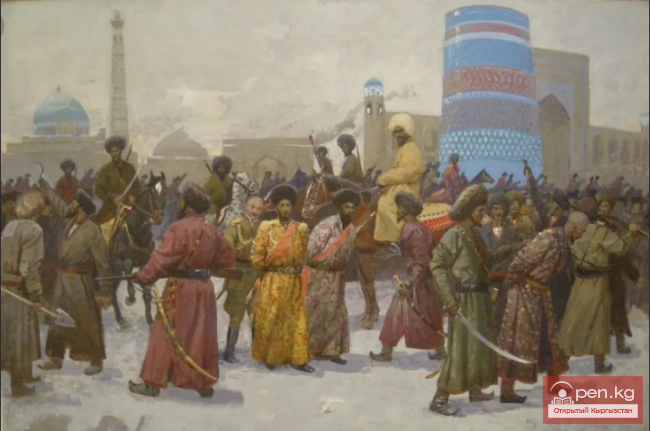
The uprisings and revolts that took place in Kyrgyzstan, as well as in Uzbekistan, Tajikistan, and...

In the middle reaches, the Sokh River receives the tributary Abghol (a river from the lake), at...

"Kyl-kuyruk" Abdurakhman Aftobachi, who had recently returned from Mecca, where he went...

The Industry of Kyrgyzstan in the Territory of Turkestan In the early 1890s, intensive exploration...

Forced Liquidation of the Kokand Khanate The tsarism, the patron of the Kokand khans, failed to...

Attempts to Circumvent Legislation on the Expansion of Waqf The conversion of real estate into...

Uprisings of the Kyrgyz against the Kokand Khanate The internecine feudal struggle between the...

Even during the time of the Kokand Khanate, the wealth of the subsoil of Kyrgyzstan was well...

During the period under consideration, the Kyrgyz population occupied approximately the same part...

Peasant Movement As the factual materials presented above show, the uprising of 1873-1876 was a...

Agriculture. According to the legislative acts of the Russian Empire, the lands of the indigenous...

Uprising of the Masses in 1873-1874 This uprising was distinguished from the previous one by its...

Bureaucratic Apparatus of Management among Southern Kyrgyz Tribes The social and property...

Flour Market of 1899. Trade. The Russian administration encouraged the development of both fair...

The territory of the republic has discovered deposits of coal, gas, and oil. Among them, coal...

Support for the Rebels by the Local Population The uprising of 1873-1876 began and unfolded as an...

Among the ready-made items purchased by Kyrgyz people, in addition to light robes, were quilted...

Kyrgyzstan - Chronology of Major Historical Events 400,000 years ago - The oldest Stone Age...

The Incorporation of Kyrgyz into Russia after the Uprising of the Population of Southern...

Historical information about the size of the multi-ethnic population of the Fergana Valley during...

CLUSTERS OF WRATH For a researcher, it is not easy to classify the protests against the...

The Republic has a significant amount of diverse fuel and energy resources. Involving them in...

Economic Transformations. In the second half of the 19th century, significant shifts occurred in...

Settlements and Permanent Housing The 19th century was a turning point in the life of the Kyrgyz....

The Struggle of the Working People Against the Khans of Kokand and the Tsarist Authority. In the...

Orientation of the Uprising Kyrgyz Workers Towards Russia The Kyrgyz workers, fighting against the...

Military-Police Administration As we can see, the ancient city at the beginning of Russian rule...

Coal deposits in the republic are grouped into 4 basins (Southern Fergana, Uzgen, Northern...

Kyrgyzstan on the Eve of the Great Patriotic War In February 1941, the workers of Kyrgyzstan...

The Liquidation of the Kokand Khanate In the spring of 1873-1874, uprisings repeatedly broke out...

The city of Osh - the center of the southern outskirts of Tsarist Russia As a result of the...

WINTER January Январь January Issyk-Kul trout completes spawning Wolves begin their mating season...

Kyrgyz Elite During the dominance of the Kokand Khanate, some changes occurred in the social...

Tax Exploitation in Pre-Revolutionary Osh After the fall of the Kokand Khanate on February 17,...

During the period in question, Kyrgyzstan was unable to conduct any foreign policy. However,...

Mulla Iskak Asan oglu — Pulad-Khan The most loyal and consistent leader of the uprising of...

Growth of the Population of Osh “Although the colonial path of development that Central Asia took...

National Liberation Uprising The uprising we are interested in took on a religious guise; however,...

The nomadic lifestyle and patriarchal-clan way of life left an indelible mark on the material...

The study of the sedentary dwellings of the southern Kyrgyz allows us to draw some conclusions....

Migration in the Alai Range. Early 20th century. Kyrgyz SSR HERDING The leading sector of the...

The Conquest of the Kyrgyz by Russia. In the last quarter of the 18th century, the southern tribes...

Osh — the regional center of the republic, the oldest city in Kyrgyzstan. Through publications of...

In the 19th century, especially in its second half, carpet weaving in southern Kyrgyzstan was...

KUTSEMELLOV Leonid Gavrilovich...

Among other domestic crafts, weaving held one of the primary places among the Kyrgyz in the past....

The second half of the 19th century and the beginning of the 20th century marked an era of...